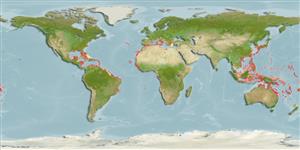Environment: milieu / climate zone / depth range / distribution range
Écologie
marin récifal; profondeur 0 - 10 m (Ref. 9710). Tropical
Western Atlantic: Bermuda, Florida (USA), and northern Gulf of Mexico to Brazil. Eastern Atlantic: Mauritania and the Canary Islands to about South Africa. Also known in the southern parts of Mediterranean, including the following most southern localities of the northern coast: Torremolinos and Taramay near Motril (Spain), Sicily, Kyra Island (Gulf of Aigina) and near Palaea Epidavros, Peloponnes (Greece) (Ref. 5298). Northwest Pacific: Japan (Ref. 559, 9137, 35771) and Taiwan.
Taille / Poids / Âge
Maturity: Lm ? range ? - ? cm
Max length : 12.0 cm TL mâle / non sexé; (Ref. 13628)
Épines dorsales (Total): 12; Rayons mous dorsaux (Total): 14-15; Épines anales 2; Rayons mous anaux: 14 - 17. Resembles P. yatabei but easily distinguished by a median series of cirri on nape. A short supraorbital cirrus present (Ref. 559). Dull green or olive with dark bars on body which extend into lower part of dorsal fin (Ref. 13442).
Adults inhabit shallow rocky areas and tide pools. They hide in empty Strombus gigas shells (Ref. 13628), holes or troughs of rocks, or between algae (Ref. 5981). Herbivorous (Ref. 13442). Feed on invertebrates as juveniles and shift to diet of algae as adults (Ref. 94105). Unusual erectile nuchal crest (Ref. 41019). Oviparous. Eggs are demersal and adhesive (Ref. 205), and are attached to the substrate via a filamentous, adhesive pad or pedestal (Ref. 94114). Larvae are planktonic, often found in shallow, coastal waters (Ref. 94114).
Life cycle and mating behavior
Maturité | Reproduction | Frai | Œufs | Fécondité | Larves
Oviparous, distinct pairing (Ref. 205).
Robins, C.R. and G.C. Ray, 1986. A field guide to Atlantic coast fishes of North America. Houghton Mifflin Company, Boston, U.S.A. 354 p. (Ref. 7251)
Statut dans la liste rouge de l'IUCN (Ref. 130435)
Can't connect to MySQL database (fbapp). Errorcode: Too many connections
